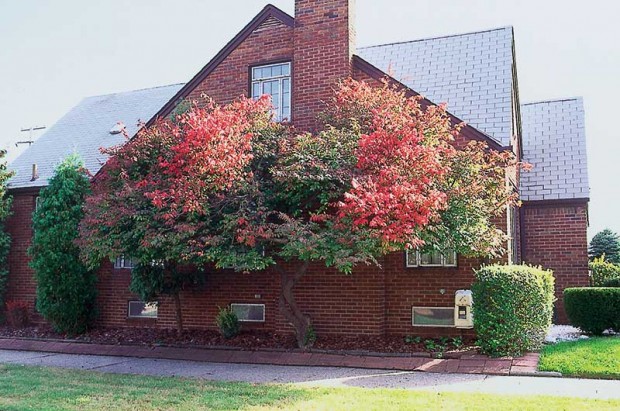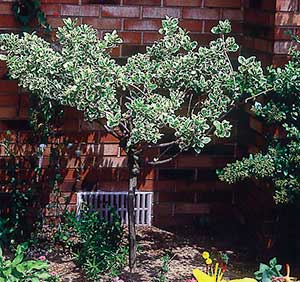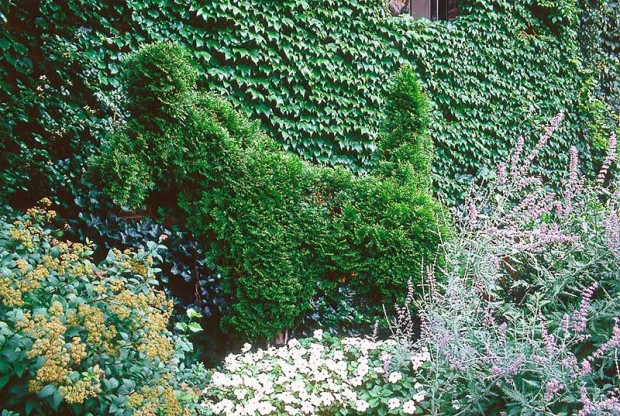
Part 1 of 2
Shrubs grown as trees and trees grown as shrubs
How much do you spend each year to stock your garden with unusual plants? How tall are the stacks of catalogs acquired in pursuit of the latest and greatest?
Here’s an alternative idea: spare your wallet and your green thumb by growing more common, easier things. You don’t have to give up your position on the cutting-edge, though—just grow your commoners in unconventional ways.
You’ve seen this approach if you’ve ever noticed a topiary juniper or Wisteria “tree.” Both are run-of-the-mill plants, one transformed through pruning, the other by staking a stem upright and clipping off all branches except those at the top until the stem is thickened and bare like a trunk.
The beauty of these treatments is that they involve plants that are dependably easy to grow, since all of their quirks and problems are well known. Ordinary plants are so widely available that they’re inexpensive to the point of being expendable. That’s important, since when we grow them in extraordinary ways we need to feel free to experiment. The very ordinariness of these plants also makes it more fun to identify them when people admire them as something special or unique: “Oh that?! It’s just an arborvitae!”

Shrubs as trees
My favorites in the unusual usual category are shrubs used as trees.
By “tree,” I don’t mean the horticultural definition of tree—a species generally taller than 20 feet but with just one or a few trunks that last its lifetime. I mean a plant in the form popularly associated with the word—a clean trunk or three, with leaf concentrated at the tops of the trunks. And what I mean by using a shrub as a tree is that we choose a shrub of suitable size—new or existing—and prune it to the classic tree form.
In that way, almost any shrub can be turned into a small tree. Just select one or a few healthy, well-placed canes, cut out all others, and remove side shoots up to the desired height. New canes or side shoots may appear and have to be removed in subsequent years. However, the best candidates for tree-dom, such as yews and bayberry, sucker very little and stop producing low side branches after the first year or two of training.
A definite drawback of tree-form shrubs is that a shrub’s canes are generally not so long-lived as a tree’s trunk. So when I cut a laceleaf buckthorn or staghorn sumac down to just three canes and limb those canes up to five feet to turn it into a small tree, it has to be with the understanding that those canes will last only a limited time – maybe ten years. Something will eventually happen to kill that wood, perhaps insect damage or dieback due to age. I’ll have to watch for the early signs of decline, such as reduced growth or premature fall color on a cane, and then allow a sucker or two to develop at the base of the plant as a replacement cane. Or when its canes begin to fail I’ll remove the shrub and start over with something new.
My favorite shrubs-as-trees are species with clean branching, such as burning bush and viburnum. To grasp what I mean by “clean,” just consider the opposite—something like tatarian honeysuckle (Lonicera tatarica) which consists of little more than a rag-taggle of criss-crossing limbs and clutter of short-lived twigs. It makes an ugly shrub and an even uglier tree.
Shrubs grown as trees—a plant list:
Bayberry (Myrica pensylvanica). Semi-evergreen, fragrant in all parts, glossy foliage. 6 feet tall, sometimes 10.
Blackhaw viburnum (V. prunifolium). 12 to 15 feet tall and wide. Pretty white flowers, fruit for the birds, great fall color.
Burkwood viburnum (V. x burkwoodii). Glossy semi-evergreen foliage and fragrant white flowers in spring. 8 or 10 feet tall.
Burning bush (Euonymus alatus, both the 8-foot dwarf and the 15-foot standard). Often mistaken for a Japanese maple for the horizontal branching and fall color.
Doublefile viburnum (V. plicatum). 8 feet tall with wonderful horizontal branches, double rows of lacy white flowers followed by brilliant red fruits and maroon fall color. Have admired it even as a single-trunked tree (at the Royal Botanical Gardens in Burlington, Ontario). Its stems are only marginally hardy in zone 5 so the trunks may die back unexpectedly unless it’s planted in a protected area.
Sargent viburnum (V. sargentii). Resembles a round-headed 12-foot crabapple, with bright red fruits that last into winter.
Shrub juniper (Juniperus chinensis, spreading forms). The initial task of cleaning off the lower portions of selected trunks can be itchy-scratchy work, but the flat-topped, 10-foot evergreen tree that can be made from a full-grown Pfitzer juniper is worth the effort.
Ural false spirea (Sorbaria sorbifolia). 8 to 10 feet tall with arching canes. I like it for leafing out very early, blooming with white sprays in midsummer that repeat if kept deadheaded, and having an overall lacy look. It is a non-stop suckerer, though, so the task of removing new sprouts from the base never ends.
Witchhazel (Hamamelis species and hybrids). 10 feet. The spring-blooming types have fragrant yellow or red-orange flowers in early spring and incredible fall color. Their branching is so clean they don’t even need pruning to look like a small tree.
Yew (Taxus varieties). Graceful, wide-spreading and feathery even in deep shade. The bark can be outstanding, like burnished cherry.

Trees as shrubs
Why turn a tree into a shrub? Usually because trees can be purchased large for immediate effect or offer fast growth that shrubs can’t match.
A tree that will ultimately grow to 35 feet, such as Eastern arborvitae, tends to have a faster growth rate than a shrub that will remain shorter, such as boxwood or Hicks yew. So arbs are widely available as tall plants at garden centers. Someone who wants an immediate, evergreen hedge is likely to buy and plant five-foot-tall arbs, then keep them clipped to size. This tree-as-shrub use is so common I won’t even list plants that can be used this way – just look for them in garden books under “hedges.”
Trees such as arborvitae, falsecypress and juniper are also frequently used to make fanciful topiary shapes.
The trees I want to call your attention to are some you wouldn’t normally think to hedge. Even as I list them you may gasp and say, “Oh, how could you put in such a gorgeous plant and then cut it!” To which I would answer, “If you don’t have room for it as a tree, why not have its leaf color or pretty bloom in a smaller space?”
Leaf color is why tricolor beech (Fagus sylvatica ‘Roseomarginata’) and red leaf Japanese maples make a beautiful hedge, rivaling barberry’s color without the thorns. They grow more quickly than you imagine, too. Of course, they can’t handle the wind and extreme temperatures that barberry can, so site such hedges carefully.
Fall color or bloom is another feature worth hedging for. I’ve kept a franklin tree (Franklinia alatamaha) cut to shrub size for four years now, just to have its camellia-like white flowers in September, without having to commit a tree-sized space to the effort. It often is still blooming in October when the leaves take on their outstanding red to purple fall color. Amur maple (Acer ginnala) and sassafras (watch out for its suckering, though!) can also be kept as hedges and light up the fall scene with their red-orange leaf color.
Then there are the trees that offer winter leaf color, and I don’t mean evergreens. English oak (Quercus robur), beech (Fagus species) and hornbeam (Carpinus betulus) grow faster than many evergreen hedge plants and hang onto their juvenile foliage through winter. Kept clipped as a hedge, they tend to have even more than the usual amount of juvenile foliage, which turns parchment color in late fall. The result is a solid, subtly colored hedge, even in winter.
Stay tuned for part 2 coming in late April.
Article by Janet Macunovich and photos by Steven Nikkila, www.gardenatoz.com.

Judy Root says
I love the way Janet always presents easy solutions to complex problems.
Her idea was one I hadn’t thought of. I look forward to part 2. Thanks.
jhofley says
Judy-
Thanks for reading, we agree!
-Jonathon